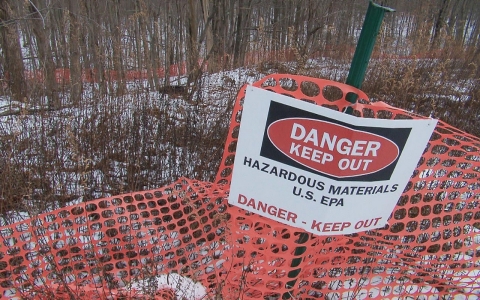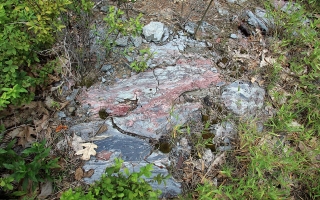Al Jazeera America, Mar. 21, 2014

Advocates seek removal of paint sludge around former Ford dump sites in NY and NJ, compensation for health problems.
by Kaelyn Forde
Chuck Stead is a tall man with an easy smile and a booming voice that rises from underneath his wide-brimmed leather hat. On a cold February morning, Stead stood outside the Ramapo Saltbox, a cabin perched on the slope of New York’s Torne Valley, where he runs an environmental research center with the help of Cornell University.
Ever since he was diagnosed with intestinal cancer and given just a few months to live last year, Stead has increased the pace of his work documenting what he calls the “toxic legacy” left in these woods by the Ford Motor Co.
“It’s not unusual to have cancer here. I don’t treat it as ‘Why me?’ It’s more like, ‘Well, yeah. It’s what happens,’” Stead, now in remission, said. “I trapped all through this creek here. I skinned all of these animals, so I was exposed to whatever they were exposed to, and we ate some of the animals. Years later, I got my intestinal cancer and my liver cancer. If you look up the cancers and then you look up the compounds that are in the automobile paint, you have a correlation right there.”
Ford produced more than 6 million cars at its plant in nearby Mahwah, N.J., from 1955 to 1980. Automobile paint containing lead, arsenic, benzene, chromium and other chemicals was sprayed on the cars rolling off Ford’s assembly line. But with large-scale production came large-scale pollution. According to the Environmental Protection Agency, during the late 1960s and early 1970s, Ford dumped millions of gallons of paint sludge in the woods surrounding Mahwah. More than 40 years later, some of the paint sludge is still there.
Among the largest dump sites were two abandoned iron mines and a landfill in Ringwood, N.J. The paint sludge is still visible in hardened lavalike pools on the forest floor, stuck between rocks and cascading down hills. Break off a chunk of the dried paint sludge and the smell of acetone is almost as potent as ever, Stead said. The paint was dumped into 55-gallon drums and then carted to places like Ringwood and Hillburn, N.Y. Some of the rusted-out drums are still visible in the woods.
“You would get $100 to make six drums disappear off of the back of the dock. Sometimes they would dump the paint directly into a trench and fill it in. That’s what I saw when I was a kid trapping up here,” Stead said.
Contamination from the paint sludge has made him and many other people here sick, he said, and no one has been harder hit than the Ramapough Indians, who have called this land home for centuries.

Ramapough clan mother Vivian Milligan embraces her sister-in-law, Janet Van Dunk, who passed away from cancer just a month after speaking with Al Jazeera America.
Al Jazeera Ramapough Chief Dwaine Perry said the approximately 3,500 tribal members who live in the area have higher rates of cancer, birth defects and other health problems from decades of contaminated water and soil. The tribe, which is recognized by the states of New York and New Jersey but not by the federal government, uses the old Dutch spelling of its name.
Like many adults here, Ramapough clan mother Vivian Milligan remembers playing in the paint sludge as a child. Some children even chewed the sweet lead-containing substance like gum because the community didn’t know it was dangerous, she said. “We used to jump around on it, and it was so enjoyable, jumping around on that pretty, colored hard stuff. And did we know it was going to affect us? No,” she said.
Milligan is one of many Ramapough who have pushed for a full cleanup of the Ford dump sites. But it has been an uphill battle.
She fears time is running out for the Ramapough as they fight for cleanup of the contamination and for acknowledgment of and compensation for their health problems.
Milligan has researched the tribe’s genealogy and life expectancy, and she said the tribe once had members live well into old age. Now, she said, the tribe is struggling to preserve its culture as its members appear to be dying younger.
“I try to write down everything — the traditions, the home remedies — before this little brain stops remembering,” she said. “But it’s very difficult when you can’t go to an elder.”
Three years after the Ford plant shut its doors in 1980, the EPA put the company’s dump sites in Ringwood, N.J., on its Superfund list of the most contaminated sites in the United States. After declaring that the Ringwood sites had been “appropriately cleaned” in 1994, the EPA found much more contamination. Ringwood was restored to the Superfund list in 2006. The latest EPA cleanup plan for Ringwood is estimated to cost $46.7 million, paid for by Ford.
In response to Al Jazeera America’s request for comment, Ford issued a statement saying the company “takes its environmental responsibility seriously and has shown through its actions a commitment to addressing the issues in Upper Ringwood … Ford is working cooperatively with the federal EPA and the New Jersey Department of Environmental Protection in the development of a final remediation plan.”

Paint sludge along Torne Valley Road, which leads to the closed Ramapo landfill in New York, just a few miles from a former Ford auto plant in Mahwah, N.J. Thomas E. Franklin/North Jersey/Landov
The current EPA plan involves excavating more than 22,000 tons of contaminated soil from around the Peters Mine pit and putting permeable caps on it and the Cannon Mine pit. Under the plan, the two pits will not be completely excavated.
“The digging out is a dangerous engineering task, and workers would be at considerable risk doing it,” said Walter Mugdan, EPA Superfund director for the Ringwood site.
He said that the caps are completely safe and that there is little risk that contamination from the mines will migrate into the groundwater. But Milligan, Stead and others in the community still want the pits dug out and the contamination fully removed.
“I can well understand why their reaction would be, ‘Get it out of my community. It shouldn’t have been there in the first place, and I don’t want it here now. Make it go away.’ I understand that. If I were living there, I would want that as well, but my task as the Superfund director here is to select a remedy that is fully protective so that, going forward, people will not be exposed to the same chemicals these poor people were exposed to in the past,” Mugdan said.
Investigative reporting by The Bergen County Record has called into question the impact the paint sludge could have on the Wanaque Reservoir, a drinking water source for more than 2.5 million people. Local officials told the Record there is concern that the chemicals could make their way into the drinking water.
Mugdan said the reservoir is routinely tested for hazardous chemicals and that the EPA will separately be making a decision on whether anything beyond capping is needed to protect it.
But the federal Agency for Toxic Substances and Disease Registry said in 2011 that the “incidence of specific cancers was not elevated” in Ringwood, compared with the rest of New Jersey.
Ramapough tribal leaders are pushing state and federal authorities for another health study that compares the cancer rate of Ramapough living in Ringwood with the cancer rate of Ramapough in uncontaminated Stag Hill, N.J.
If the study confirms what the Ramapough have long believed, then the battle for compensation will be a lot easier. In the meantime, they will continue to push for a cleanup. “It’s very hard to get [compensation] out of them. But what we can get out of them is full extraction and full removal,” said Stead.



